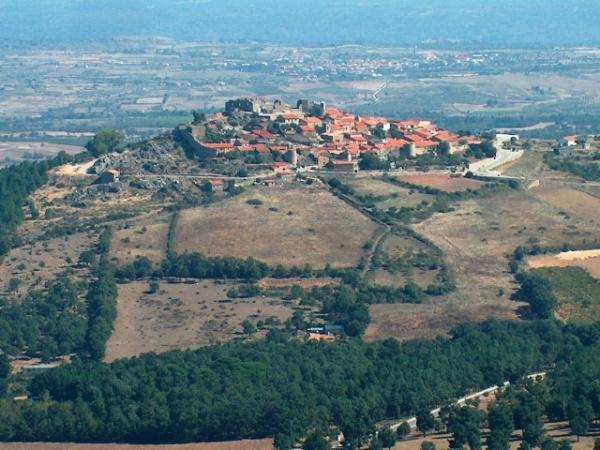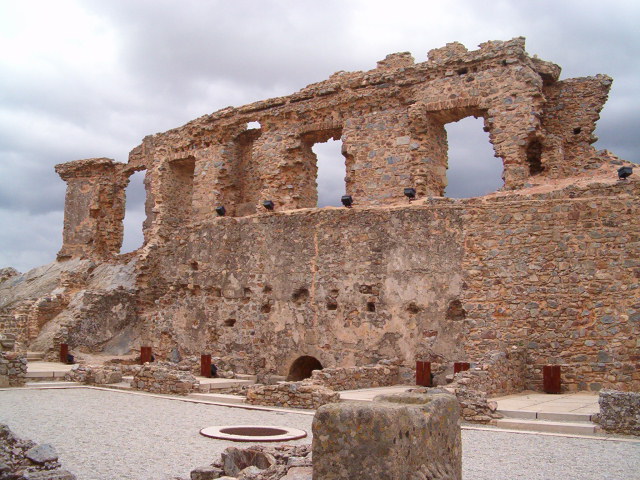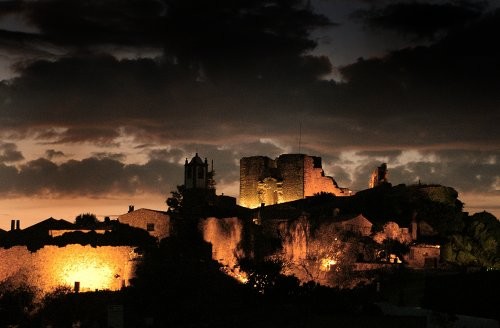CasteloRodrigo

[PT] O território de Riba-Côa foi ocupado desde o Paleolítico,
havendo vestígios megalíticos e da cultura castreja, romanos e
árabes.
A preocupação com a reorganização e povoamento desta área na época
da Reconquista é patente nas doações aos freires Salamantinos,
fundadores da Ordem de S. Julião do Pereiro, e aos primeiros frades
de Santa Maria de Aguiar, oriundos de Zamora, de que o Mosteiro de
Santa Maria de Aguiar, de fundação cisterciense do séc. XII, é
importante testemunho.
Conquistada aos Árabes no séc. XI e dependente do Reino de Leão,
foi vila elevada a concelho por Afonso IX, integrando
definitivamente o território português, pelo Tratado de Alcanizes -
assinado por D. Dinis, que confirmou o seu Foral em Trancoso e
mandou repovoar e reconstruir o Castelo, acção repetida por D.
Fernando, que também lhe concedeu Carta de Feira, em
1373.
Castelo Rodrigo está rodeado por uma cintura amuralhada
inicialmente composta por 13 torreões (à semelhança de Ávila), de
que restam alguns, e cujo passeio de ronda se encontra parcialmente
obstruído pelas casas aí construídas. Mantém a sua traça medieval,
que irradia da alcáçova e acompanha a topografia.
Pelas suas ruas encontram-se casas interessantes, umas manuelinas,
outras construções árabes, como a casa n° 32, com inscrição e uma
carranca, para além da cisterna, com uma porta em arco de ferradura
e outra ogival.
Estando na rota de peregrinos a Compostela, aqui se ergueu a Igreja
de N. Sra. de Rocamador, fundada por uma confraria de frades
hospitaleiros vindos de França no séc. XIII. Dispõe de cachorrada
românica e no seu interior destacam-se um púlpito renascentista em
granito, imaginária do séc. XIV e XVII, o tecto em caixotões com
pintura barroca e um retábulo rococó.
Por ter tomado partido por Castela na crise de 1383-85, D.João I
castigou Castelo Rodrigo, mandando que o seu brasão ficasse com as
armas reais invertidas, e a vila dependente de Pinhel.
O pelourinho manuelino - de gaiola e grandes dimensões - atesta o
poder municipal, regulamentado pelo foral novo de 1508, altura em
que D. Manuel, o Rei Venturoso, mandou repovoar a vila e refazer o
castelo.
Sob domínio filipino instituiu-se o condado e marquesado de Castelo
Rodrigo na pessoa de Cristóvão de Moura, que mandou edificar um
Palácio.
Após a Restauração este foi destruído pelo povo. Próximo da Porta
do Sol, o padrão assinala e comemora a restauração da independência
nacional.
Ainda nas lutas contra Espanha, a vila sofreu em 1664 o cerco do
Duque de Ossuna, tendo a sua guarnição de 150 homens resistido
heroicamente até à chegada de reforços, travando-se a batalha da
Salgadela, junto ao Mosteiro de Santa Maria de Aguiar. Conta-se que
o Duque de Ossuna e D. João d'Áustria escaparam disfarçados de
frades.
Após as Guerras da Restauração, Castelo Rodrigo foi perdendo a sua
importância, e a 25 de Junho de 1836, por Carta Régia de D. Maria
II, a sede de concelho passou para Figueira de Castelo
Rodrigo.
Historicamente, nenhuma povoação raiana exerceu por tão longo
período um lugar tão relevante nas relações Luso-Castelhanas e na
defesa do território português.

[EN] The territory of Riba-Coa has
been occupied since the Palaeolithic, with megalithic culture and
the Celtic, Roman and Arabic.
The concern with the reorganization and settlement of this area at
the time of the Reconquista is reflected in donations to the friars
Salamantinos, founders of the Order of St. Julian's Pereiro, and
the first friars of Santa Maria de Aguiar, from Zamora, that the
Monastery of Santa Maria de Aguiar, century Cistercian
foundation.
XII, it is important testimony.
Captured from the Arabs in the century. XI and dependent on the
Kingdom of León, was elevated to town council by Alfonso IX,
finally integrating the Portuguese territory, the Treaty of
Alcanizes - signed by D. Dinis, who confirmed its Charter in
Trancoso and sent repopulate and rebuild the castle, repeated
action by D. Fernando, who also granted the Charter Fair in
1373.
Castelo Rodrigo is surrounded by a fortified perimeter initially
comprised of 13 turrets (like Avila), which remain few, and whose
tour round is partially obstructed by the houses built there.
Retains its medieval traces, which radiates from the citadel and
follows the topography.
Its streets are interesting houses, some manueline, other
constructions Arabs, like the house No. 32, with registration and a
scowl, in addition to the tank, with a horseshoe-arched door and
another ogival.
Being
on the route of pilgrims to Compostela, here stood the Church of
Mrs. de Rocamador, founded by a coterie of hospitable monks from
France in the century. XIII. It features dogs in Romanesque and
inside stand out a Renaissance pulpit in granite, imaginary
century. XIV and XVII, the coffered ceiling with baroque paintings
and a rococo altarpiece.
For having sided with Castile in the crisis of 1383-85, John I
chastised Castelo Rodrigo, sending your coat to stay with the royal
arms reversed, and the village dependent Pinhel.
The pillory Manueline - and large cage - attests to the municipal
power, regulated by the new charter of 1508, when D. Manuel the
Fortunate King, had to repopulate the village and rebuild the
castle.
Under Philippine area was instituted and the county marquis de
Castelo Rodrigo in the person of Cristobal de Moura, who had built
a palace.
After the Restoration it was destroyed by the people. Near Puerta
del Sol, the standard marks and commemorates the restoration of
national independence.
Still in the struggle against Spain, the town has suffered in the
1664 siege of the Duke of Osuna, with its garrison of 150 men
resisted heroically until the arrival of reinforcements, is waging
the battle of Salgadela near the Monastery of Santa Maria de
Aguiar. It is said that the Duke of Osuna and D. John d'Austria
escaped disguised as monks.
After the Wars of Restoration, Castelo Rodrigo was losing its
importance, and June 25, 1836, by royal charter of King Mary II,
the county seat moved to Figueira de Castelo Rodrigo.
Historically, no borderland village occupied for so long a place so
important in relationships Luso-Castilian and Portuguese in
defending territory.

A Cache
[PT]
As
coordenadas publicadas são de um possivel estacionamento. A cache é
o resultado final de um passeio turístico por Castelo Rodrigo. Com
a sua visita e os vários elementos recolhidos vai chegar a
coordenada da cache!!
Achamos que assim pudera desfrutar de uma visita
integral a Castelo Rodrigo e conhecer assim toda a sua Historia.
Aproveitar ainda e deixar-se envolver pela calma e os óptimos ares
desta bonita região.
Para realizar esta cache terão que encontrar primeiro o número
escrito no logbook da cache:
Convento de Santa Maria de Aguiar- FCR
O
container poderá levar TB’s e GC’s.
O container final, contem de inicio:
- LogBook
- Lapis
-
GC
- ...
e surpresas..
Para
chegarem à cache só terão que efectuar os seguintes cálculos:
N 40° (D x 18 -F). (C-738)
W
006° (A x 7 + G). (B x E x H) -
80
Tirem
fotos ás vistas…agradecia que não colocassem nenhuma foto
spoiler.
Boas
Cachadas
[EN]
The coordinates listed are those of a
possible parking. The cache is the end result of a tour by Castelo
Rodrigo. His
visit and the various elements collected will reach coordinated
cache!
We think so been able to fully enjoy a visit to Castelo
Rodrigo and so know all their history. Getting still and let yourself in the
quiet and the great air of this beautiful region.
To
accomplish this cache will have to first find the number written on
the logbook of the cache:
Convento de Santa Maria de Aguiar - FCR
The container could lead TB's and GC's.
The container end, contains a start:
• Logbook
• Lapis
• GC
• ... and surprises ..
To reach cache only have to perform the following
calculations:
N 40 ° (18 x D-F). (C-738)
W 006 ° (A x 7 + G). (E x B x H) - 80
Take pictures of the sights ... I'd
appreciate any photos that do not put
spoiler.
Good Hunt